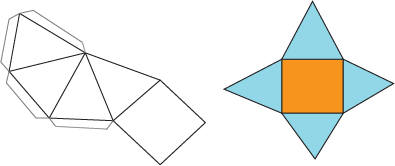When we slice and dice 3D shapes, we end up with interesting 2D figures. What we're doing is intersecting a plane (a 747, to be exact) with the shape to find its cross-section. We'll turn on the fasten seat belt sign, as there may be some turbulence.

If we intersect a horizontal plane with a cylinder, we get a circle. But if we use a vertical plane, we get a rectangle. Cross-sections are useful to understand if you ever want to cut things into pieces. Like papers or muffins or that Furby that's still giving you nightmares. Yikes.
If we can make 2D shapes out of 3D ones, we should be able to make 3D shapes out of 2D ones. We can! It's called origami.
For those of us less skilled in the Japanese art of paper-folding, we can use nets, which are essentially the same thing. Nets look like cut open cardboard boxes, like this:

Nets are patterns for creating 3D shapes. There can be multiple nets for the same shape, but they can't have any overlapping sides. For instance, the net for a square pyramid can look like either one of these:

The reason nets are useful is because they catch fish and calculate surface area. Surface area is the sum of the areas of each face on a solid. It's the same as calculating how much wrapping paper you'd need to cover the entire solid perfectly. That'll definitely come in handy when you "accidentally" break your sister's demonic Furby and your parents make you buy her a present to make up for it. Actually, you might as well start working on surface area now.
Sample Problem
What's the surface area of this triangular prism?

If we draw the net for this figure, it should look like this. The sides are labeled with the units we know and the areas are A through E.

The sum of all the areas of the triangles and rectangles should give us the surface area. That means SA = A + B + C + D + E. What are we learning here, math or the alphabet?
Now we can get down to calculating the areas of these puppies. C is a square with side length 6, so its area is:
C = s2
C = 62
C = 36 units2
We know the dimensions of D, so we can calculate the area of that rectangle.
D = bh
D = 6(10)
D = 60 units2
So far, so good. To calculate A, B, and E, though, we need to find the height of the prism. We can use the Pythagorean Theorem to do that.
a2 + b2 = c2
62 + b2 = 102
b2 = 64
b = 8 units
That wasn't too bad. Now to find the rest of the areas. First the rectangle.
B = bh
B = 6(8)
B = 48 units2
Now the triangles.
A = ½bh
A = ½(6)(8)
A = ½(48)
A = 24 units2
Since A = E, the area of E is also 24. We're ready to plug in our values and find the surface area.
SA = A + B + C + D + E
SA = 24 + 48 + 36 + 60 + 24
SA = 192 units2
Get out your chainsaw, find all the cross-sections of that Furby, and then gift-wrap something way less creepy for your sister.